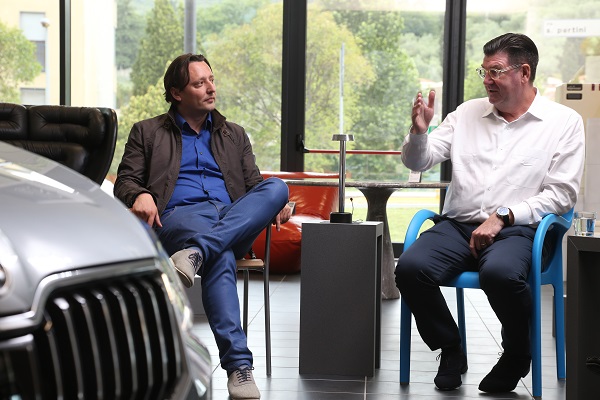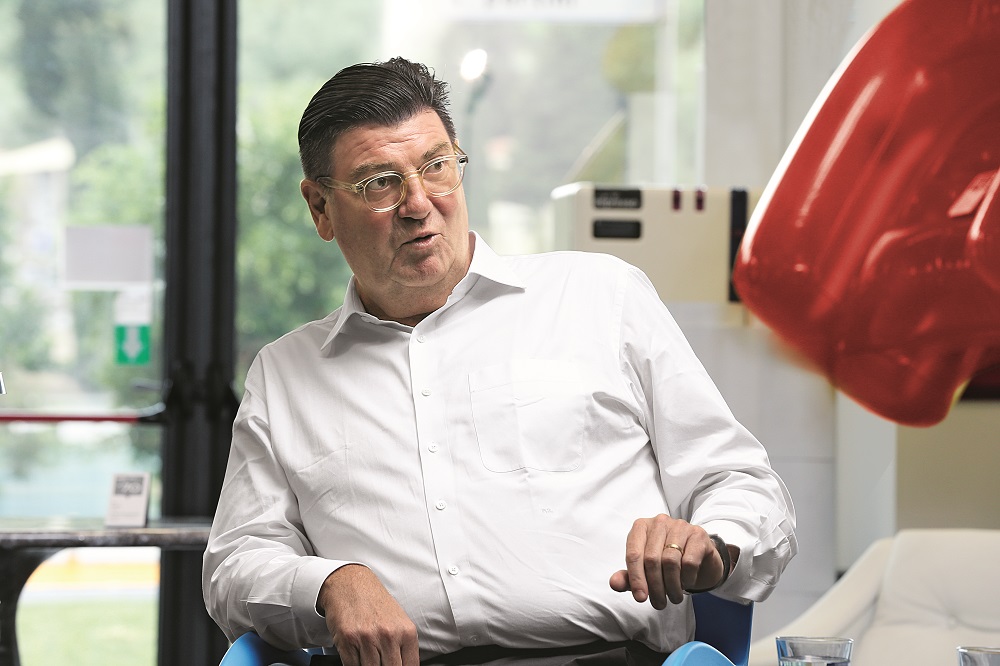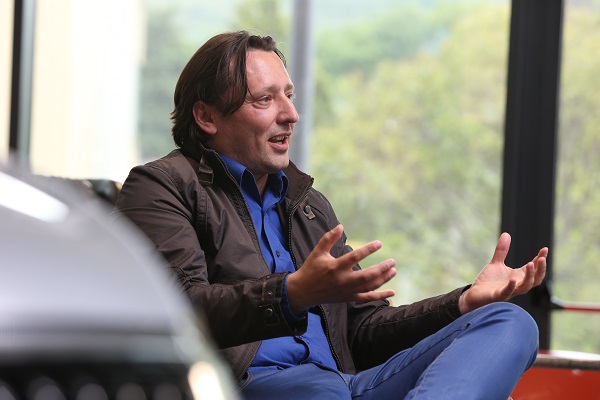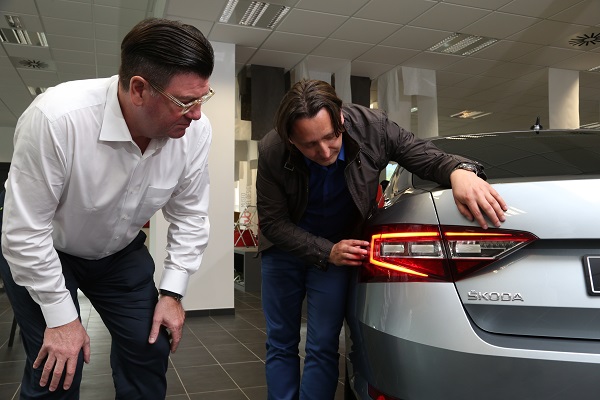Price? Performance! From the art of appealing - a Florentine summit talk
The automotive industry is characterized by high technical standards in all classes of vehicles. Therefore, manufacturers focus on another form of distinction in order to prove themselves on the market. In addition to aspects like comfort and safety, a good design has become a crucial factor in the purchase decision and is therefore a guarantor of economic success. This trend becomes apparant in the annually growing number of participants from the automotive industry in the Red Dot Award: Product Design.
Among the companies, which compete in the largest international design competition, belongs Škoda. 2015, already the eighth series of the Czech automobile manufacturer has been awarded in the Red Dot Design Award: The reshaped Fabia was honoured with the “Red Dot”, the seal of quality for good design. On the occasion of the Red Dot Gala on 29 June, Škoda Chief Designer Jozef Kabaň and Professor Dr Peter Zec, founder and CEO of Red Dot, have met for an intensive exchange of function and action of automotive design. The conversation took place at the design campus of the Università degli Studi di Firenze.
Prof. Dr. Zec, let us come straight to the point. Can you tell us what it was about the new Fabia that wowed the Red Dot jury?
Prof. Dr. Zec: First of all, it is important to note that the Red Dot jurors have extensive experience when it comes to car design. Therefore, they naturally have a good eye for a good signature design, not only with regards to eye-catching cars. With the Fabia, it is the lines: its silhouette is clean and neat, the lines run parallel. There are no frills, no wrong curves. The car holds an incredibly dynamic view. And what was particularly convincing: when you get in and see the interior... the space is outstanding. All of that together was assessed and - I believe, quite rightly - awarded with the Red Dot.
Would you say that good design is inevitably required to be suitable for the mass market?
Prof. Dr. Zec: There are studies demonstrating that when making a buying decision, particularly in the automotive market, between 80 and 85 per cent is based on the car’s design. Also when ‘brand loyalty’ and ‘design’ are compared, design wins out. In other words, customers switch brands when they don’t like the design any more.
Why are customers not involved with Red Dot? Aren’t designers judging designers without thinking of the customer who is, in the end, going to be using the product?
Prof. Dr. Zec: The history of this award must be taken into consideration. Effectively, the award was founded by designers for designers, as often the following is the case: products are designed, and if they are successful, the success is attributed to great marketing, and super pricing. And product development did a good job. But design is irrelevant. But if a product isn’t successful, then the design was wrong. Against this background, at the time it was a kind of ‘designers’ self-help’. They wanted to have the quality of work evaluated. For that you need experts.
Mr. Kabaň, how much ‘customer’ is put into your design?
Jozef Kabaň: A lot and a little at the same time. We have to be mindful not to ask too much of the customer. The customer doesn’t have an easy task: it takes time for design to be accepted. Sometimes only the experts can recognise the potential. For the consumer, this may be more difficult at first glance. An example: we never could have brought the internet into cars, if we had solely asked our customers. A few years ago, they didn’t want it yet. I didn’t know myself that I would need mobile internet. Nowadays, I’m constantly with my mobile phone when I’m on the move. I have ‘the entire office’ with me at all times. Had someone asked me 20 years ago, I probably wouldn’t have considered this development possible. New things take time.
In other words, design is also a matter of education? Or is there something along the lines of a universally valid design?
Jozef Kabaň: Of course, designers work to some extent ahead of time. They simultaneously turn visions and emotions into a reality. Man has always tried to transform his emotions into sheet metal or other things. And by doing so, providing the material with additional value. Or not, as the case may be. In the past, that occurred most of all in art, in paintings, sculptures. That was pure emotion. Nowadays, everyday objects are not only looked at as functional objects, but they are also viewed with emotion. Because, ultimately, it is much nicer when something that I use functions perfectly, and on top of that I can also enjoy it. The creative realisation of emotions increases in importance and influences purchasing decisions. At ŠKODA, we are perfectly aware of that.
Speaking of functionality: ŠKODA was and is famous for building very functional cars. Is ŠKODA now turning into a designer brand?
Jozef Kabaň: No, we are not planning on becoming a designer brand, and I think that is a good thing. My dream is just to combine the most beautiful aesthetics with maximum functionality, to bring both of those together so that we don’t speak of two separate things any more. We are attempting to find beauty in simplicity, without disregarding functionality, ergonomics and safety. Because a car should, in the first instance, fulfil its purpose. There are so many requirements in a car that are considerably more important than design. Design makes functionality attractive.
If design takes time to be accepted by the customer, why can’t the customer educate the designers, by telling them what they want and what makes them happy?
Prof. Dr. Zec: It takes a very long time to change people’s habits. For that reason, the biggest challenge with products as expensive as cars which have long development cycles, is to balance tradition with innovation. In other words, if you are too innovative, you lose the brand. You can’t assign the cars any more. But if you are too traditional, the cars are boring.
Jozef Kabaň: You must know your customers, know what steps they are willing to take to go along with you. If you overdo the innovation, you lose these customers. If you downplay it, you will also lose them. Perhaps not today, but tomorrow.
As you said, a car has to fulfil many functions, design is one of those. Qualitatively and technologically, the field is moving ever closer together. In your view, will the design therefore further increase in importance?
Jozef Kabaň: I believe design is key. Because: if technology moves closer together, it will be the design that differentiates things. But it is not the design alone, but the combination of everything that constitutes a good car. Alongside technology, there is space, there is the ergonomics, the materials that you choose. As Prof. Zec said, the balance has to be right. You can overload a car with design or with technology. From a ŠKODA perspective, I would say: a car should not turn into the focal point of life. But it is and remains a distinguishing feature. With their car, people also reveal something about themselves. Take the new Superb: as the flagship of the ŠKODA brand, it has among other things the task of providing the driver - and also the brand - with more self-assurance. It is not only rationality that they choose, but also aesthetic added value. The Superb also has a representative function. It is not a premium car, but it must radiate self-assurance and charisma next to the premium brands.
Professor Zec, if the choice of car does indeed say something about the driver, which attributes do you associate with the driver of a Superb?
Prof. Dr. Zec: A solid person who knows how to appreciate technical quality and aesthetics. Someone understated who doesn’t overdo things.
What are the elements that represent the ‘look’ of all ŠKODA vehicles and that we can count on also in the future?
Jozef Kabaň: It is important not to tie ourselves down too much to one thing. But despite that, I expect us designers to define dreams. I need to know the direction we’re heading in. The strongest car with a full tank doesn’t help me if I don’t know where to go. Cars from ŠKODA will also in the future set themselves apart from the competition thanks to their convincing balance between functionality and aesthetics. An important design feature of our products is, for example, the vertical grille which we will certainly retain. It combines the tradition and future of our brand. Another example is the headlights used in our cars, with which we would rather establish an association with the human eye than with the technology itself. When you look at a ŠKODA, you should have the feeling of looking into a person’s eyes rather than looking at a high-tech product. The mindset of our brand is very close to the mindset of people.
Are there studies showing to what extent an award such as the Red Dot influences consumer buying behaviour?
Prof. Dr. Zec: We can’t quantify it exactly. But: if you look at the industries represented with us, then you would probably be very surprised that bath tubs have such a great need for a design award. In particularly saturated markets, such an award can make all the difference. Also when it comes to mobile phones and laptops. Here there is tremendous comparability and tremendous competition. Given that, the manufacturers use the Red Dot label accordingly. Therefore anywhere where another particular selling point is needed. With products that become popular anyway because they have the market to themselves, it is more important for the designers to receive the accolade.
Mr Kabaň, how important is it for you, as a responsible designer, to receive such an award?
Jozef Kabaň: Of course it wasn’t our primary aim. Our primary aim is to attract as many people as possible to the ŠKODA brand with our products. Despite that, awards such as the Red Dot are very important to us designers. What is better than recognition from our customers and our colleagues. The bar is set very high with Red Dot. The jury is highly qualified. To win a Red Dot is very motivating for every designer.
Have you already submitted an application with the Superb?
Jozef Kabaň: Not yet, but hopefully nothing will stand in the way of that.
Professor Zec, what do you think: Is the new ŠKODA Superb worthy of a Red Dot?
Prof. Dr. Zec: I very much hope that ŠKODA will submit an application for a Red Dot with the new Superb. The Superb has a great silhouette and is a wonderful car. But I am not a member of the jury, and you will certainly understand that I would not wish to influence the judgement of my colleagues in any way.




